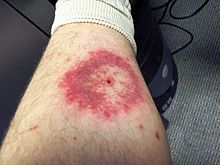Erythema migrans
-
Erythema migrans ("redness migrating") and may have no definite pattern, as in this Lyme rash on a woman's neck.[4] Rashes from non-Lyme causes may look similar.[1][5]
Erythema migrans or erythema chronicum migrans is an expanding
Lyme disease
"Erythema migrans is the only manifestation of Lyme disease in the United States that is sufficiently distinctive to allow clinical diagnosis in the absence of laboratory confirmation."[8][9] Often, but not always, mentions of a target lesion (bull's-eye lesion) are talking about erythema migrans. However, the appearance of erythema migrans can vary considerably: while some look like a bull's eye, in the U.S. most are evenly red or bluish, without a central or ring-like clearing.[10][3][11] A minority of patients never have any rash. Because Lyme disease can within a few weeks cause long-term neurologic complications, persons with a rash and recent history of outdoor activities where Lyme is common should seek a doctor for diagnosis.[11]
Presentation
The initial sign of about 80% of Lyme infections is an erythema migrans (EM)

The EM rash is often accompanied by symptoms of a viral-like illness, including fatigue, headache, body aches, fever, and chills, but usually not nausea or upper-respiratory problems. These symptoms may also appear without a rash, or linger after the rash disappears. Lyme can progress to later stages without these symptoms or a rash.[10]
A person with an asymptomatic EM rash can easily miss its significance. However, if the initial EM rash is not treated, the infection can disseminate through the lymphatic system or blood. Within days or weeks, additional EM rashes, usually smaller, can appear at other sites, or the infection can cause more serious complications in the nervous system, heart, or joints.[1][10]
Southern tick-associated rash illness

Southern tick-associated rash illness (STARI) produces a similar rash pattern although it develops more quickly and is smaller.[14] This erythema is also sometimes called erythema migrans[15] or EM. The associated infectious agent has not been determined. Antibiotic treatment resolves the illness quickly.[6][7]
Treatment
Both Lyme disease and STARI can be treated with
Amoxicillin in children less than 8 years of age.History
In a 1909 meeting of the Swedish Society of Dermatology, Arvid Afzelius first presented research about an expanding, ring-like lesion he had observed. Afzelius published his work 12 years later and speculated the rash came from the bite of an Ixodes tick, meningitic symptoms and signs in a number of cases and that both sexes were affected. This rash was known as erythema chronicum migrans, the skin rash found in early-stage Lyme disease.[18]
In the 1920s, French physicians Garin and Bujadoux described a patient with meningoencephalitis, painful sensory radiculitis, and erythema migrans following a tick bite, and they postulated the symptoms were due to a
References
- ^ from the original on 27 September 2013.
- ^ PMID 17579230.
- ^ a b c d "Lyme disease rashes and look-alikes". Lyme Disease. Centers for Disease Control and Prevention. 2018-12-21. Retrieved April 18, 2019.
- PMID 38407256.
- PMID 30216021.
- ^ a b "Lone star tick a concern, but not for Lyme disease". U.S. Centers for Disease Control and Prevention (CDC). Retrieved 2017-10-06. Page last reviewed: October 22, 2015
- ^ PMID 28605419.
- PMID 17029130.
"pp. 1101–2 Background and Diagnosis of Erythema Migrans
- PMID 18290267.
- ^ PMID 24785207. Archived from the original(PDF) on 19 October 2016.
- ^ PMID 24818260.
- PMID 11900494.
- PMID 11982300.
- ^ Goddard J (2017) Not all erythema migrans lesions are Lyme disease. The American journal of medicine, 130(2), 231-233.
- ISBN 978-1-4160-2999-1.
- PMID 11372036.
- PMID 18580719.
- ^ Lipschütz, B. (1931). "Zur Kenntnis der "Erythema chronicum migrans"". Acta Dermato-Venereologica. 12. Stockholm: 100–2.

![In Europe, 80% of Lyme rashes look like a "bull's eye," but in only 20% of cases in the United States. (20 percent of Lyme infections show no rash.)[1][2][3]](http://upload.wikimedia.org/wikipedia/commons/thumb/8/8e/Bullseye_Lyme_Disease_Rash.jpg/180px-Bullseye_Lyme_Disease_Rash.jpg)
![Erythema migrans ("redness migrating") and may have no definite pattern, as in this Lyme rash on a woman's neck.[4] Rashes from non-Lyme causes may look similar.[1][5]](http://upload.wikimedia.org/wikipedia/commons/thumb/0/03/Solid_erythema_migrans_rash_on_the_neck_of_a_woman_with_Lyme_disease.jpg/180px-Solid_erythema_migrans_rash_on_the_neck_of_a_woman_with_Lyme_disease.jpg)

